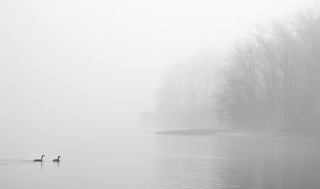"It is easy to take a photograph,
but it is harder to make a masterpiece
in photography than in any other art medium."
- Ansel Adams
To Ansel's sage words I can add my own corollary that it is easy to write a book about photography, but it is harder -
much harder - to create a masterpiece in this genre than in any other "here are my musings about..." creativity-centric medium. That
Guy Tal has not only done so - that is, created a masterpiece of a "book about photography" - but has also seamlessly and additionally woven in a commensurate degree of timeless wisdom on art, creativity, and life, is nothing short of breathtaking. To paraphrase
Martin Gardner's often quoted (essentially one-line) 1979
review of
Godel, Escher, Bach ("Every few decades, an unknown author brings out a book of such depth, clarity, range, wit, beauty and originality that it is recognized at once as a major literary event"): every decade or so, a book of such stunningly original beauty and elegance appears that it self-evidently redefines how the essence of a creative life may be communicated with 'mere' words. Tal's book is, arguably, this decade's book, and is one to which I happily give my highest and unqualified recommendation.
With the publication of
More Than a Rock, Tal joins a small pantheon of preternaturally gifted guides to the core truths that underlie all aesthetic yearning and creative expression. My
personal list includes: Doug Beasley, Nicloas Hlobeczy, Brooks Jensen, George DeWolfe, Freeman Patterson, John Daido Loori, Deborah Dewit Marchant, and (of course) Minor White. Yet, even among even these elites, Tal is unique in his ability to use the simplest intuitive language to express ineffable truths; his graceful style gently leads the reader, never pushes. Even those who have rarely if ever pondered "deep" questions while putting their eye behind a camera's viewfinder will inevitably find themselves eagerly and effortlessly tagging along on an amazing journey of ever-widening discoveries; including ways of
finding art (in everything around us), of
making art (alongside discovering ways of communicating what we have found and wish to share), and of
discovering oneself by losing the ego to the creative process. This is not just hard to do; I had thought it
impossible to do, before "eagerly tagging along" Tal's unpretentious, sage-like insights.
A dry recitation of the book's layout and content hardly does justice to what it really contains, but for those interested: it is broken into 4 sections (on art, craft, experiences, and meditations), and each section consists of short essays (most between 2 to 5 pages long) on specific topics, accompanied by a selection of photographs. What you will not find, unlike what typically makes up the vast majority of photography books (including those that purport to "reveal hidden truths") is any discussion about f-stops, lenses, or why Canon is so much better or worse than Nikon. These concerns, for Tal, are (and ought to be) as unimportant to serious photographers as discussions of the proverbial pots and pans are for chefs (and for those who aspire to become chefs). Each essay begins with a short quote - sometimes attributed to a well known artist or photographer, but just as often to a poet or philosopher - which sets the stage for brilliantly concise meditations that simultaneously leave the reader both in wonderment about how much has been said in so short a space, and a compulsion to just keep reading, looking, absorbing.
My advice is to take Tal's book in slowly, contemplatively; take time to digest and assimilate what it has to offer. Though your mind will initially digest its contents, the book's real message speaks directly to your soul. Of course, the book can also be perused simply for Tal's imagery, which is masterful.
It is no coincidence that
Lenswork magazine (perhaps the preeminent fine-art photography publication available today) has commissioned Tal to contribute an essay for each of its bi-monthly issues. He is a unique talent, and this book - and his essay/column in
Lenswork - are precous gifts for this, and future, generations of photographers. It is available via
Amazon and
Barnes & Noble (in both print and eBook forms; though my review is based on the print version); and from Tal's own
website, which rewards the customer who takes this last option by shipping a copy of the book that includes the author's signature.
Full disclosure: I have never met Guy Tal in person, though I have (on the heels of purchasing his book from a local Barnes & Noble) "friended" him on facebook. As readers of my blog know, I am also a fellow alumnus of Lenswork, but my mention of Lenswork has to do only with the fact that - as ought to be clear from my review - I am simply delighted as a reader of the magazine that I can look forward to Tal's column each issue.
















































